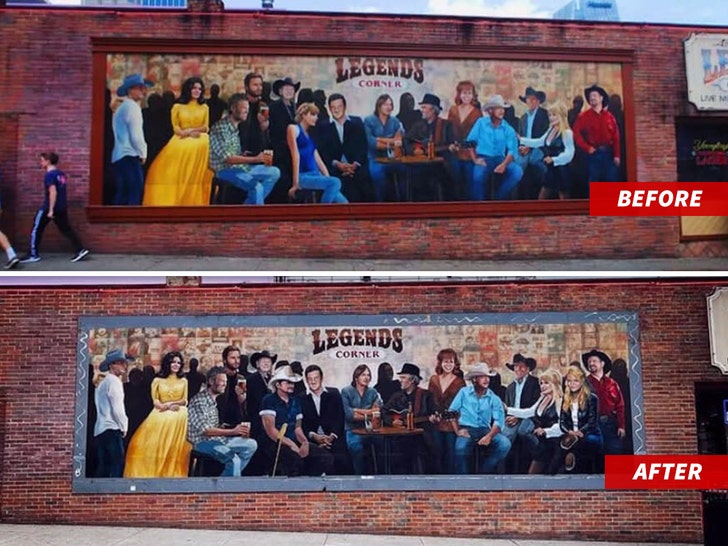In December 2020, a seemingly routine update to a famous mural at Legends Corner bar in Nashville, Tennessee, ignited a firestorm of controversy. The mural, a celebrated tribute to country music’s most iconic figures, underwent a significant overhaul that saw pop superstar Taylor Swift removed and replaced by country artist Brad Paisley. The decision, made by the bar’s owners and executed by muralist Tim Davis, provoked outrage among Swift’s devoted fanbase, known as Swifties, and sparked a broader debate about her legacy in country music, the criteria for “legendary” status, and the evolving nature of the genre. This article delves into the details of the controversy, the reasons behind Swift’s removal, the reactions from fans and the public, and the subsequent efforts to honor her legacy in Nashville.
The Legends Corner Mural: A Symbol of Country Music Heritage
Located in the heart of Nashville’s Lower Broadway, Legends Corner is a historic honky-tonk bar that has long been a pilgrimage site for country music fans. The mural on its exterior wall, unveiled around 2017, is a vibrant celebration of the genre’s past and present. Featuring 14 of country music’s most revered artists, including Willie Nelson, Johnny Cash, Dolly Parton, Reba McEntire, and Blake Shelton, the mural serves as both a tourist attraction and a visual testament to Nashville’s status as the epicenter of country music. Taylor Swift, who rose to fame as a teenage country prodigy, was prominently featured, perched on a barstool between Nelson and Cash—a position that underscored her early contributions to the genre.
Swift’s inclusion in the mural was a nod to her meteoric rise in country music. Her debut album, Taylor Swift (2006), released when she was just 16, introduced hits like “Tim McGraw” that resonated with country audiences. Her follow-up, Fearless (2008), became the most-awarded country album in history, earning a Grammy for Album of the Year and cementing her status as a country music darling. Albums like Speak Now (2010) and Red (2012) further solidified her influence, with the latter earning her the prestigious Pinnacle Award at the 2013 Country Music Association (CMA) Awards—the first time a woman received the honor. Swift also won the CMA’s Entertainer of the Year award in 2009 and 2011, milestones that highlighted her dominance in the genre.
However, by 2014, Swift began transitioning to pop with her album 1989, a move that expanded her global reach but distanced her from her country roots. While she occasionally revisited country influences—most notably in her 2020 albums Folklore and Evermore—her primary focus shifted to pop and alternative sounds. This evolution would later become a central point of contention in the mural controversy.
The Removal: Why Was Taylor Swift Replaced?
In late December 2020, artist Tim Davis began updating the Legends Corner mural, a process that included adding new artists and reconfiguring existing ones. The most significant change was the removal of Taylor Swift, whose image was painted over and replaced with Brad Paisley, a country music stalwart known for hits like “Whiskey Lullaby” and “Mud on the Tires.” The decision, Davis clarified, was not his own but that of the bar’s owners, who intended to periodically refresh the mural to reflect the genre’s evolving landscape.

Davis provided insight into the reasoning behind Swift’s removal in an email to USA Today. He noted that some local bar patrons had expressed discontent with Swift’s presence on the mural, citing her shift to pop music as a betrayal of her country roots. “I have heard many complaints here in Nashville about Taylor being on the wall with country legends since she is currently focused mainly on pop,” Davis stated. “Some inebriated bar hoppers have spit on her image specifically, feeling betrayed by her venture from country.” Despite these sentiments, Davis emphasized his personal admiration for Swift, adding, “By and large, the people of Nashville love her, as do I.”
The decision to replace Swift with Paisley was not without precedent. The bar owners had always planned to update the mural periodically, and Paisley’s addition was part of a broader overhaul that would see three more artists added in January 2021, including a female artist sketched between Dolly Parton and Garth Brooks. However, the optics of removing one of only four women on the mural—leaving just Parton, McEntire, and Loretta Lynn—drew sharp criticism, particularly given Swift’s undeniable contributions to country music.
Swifties Strike Back: The “Young Taylor Ran Country” Movement
The news of Swift’s removal spread rapidly on social media, particularly on Twitter (now X), where her fans mobilized to defend her legacy. Within hours, the hashtag “#YOUNGTAYLORRANCOUNTRY” began trending worldwide, with Swifties highlighting her groundbreaking achievements in country music. Fans pointed out that Swift, at age 23, became the youngest recipient of the CMA’s Pinnacle Award and that Fearless remains the most-awarded country album ever. They argued that her contributions to the genre, including mainstreaming country-pop and attracting a younger, global audience, warranted her place among the legends.
One Twitter user, @MissAmericHANA, wrote, “Taylor Swift did not become the first woman to be awarded the Pinnacle Award and contributed so much to country music only to be replaced on a Nashville mural, utter disrespect.” Another fan tweeted, “ARE THEY FR???? COUNTRY WAS ONLY RELEVANT THIS CENTURY BECAUSE OF TAYLOR!!! SHE MADE IT MAINSTREAM WTF.” The sentiment was echoed across platforms, with fans arguing that removing Swift in favor of “another dime a dozen white dude” was a missed opportunity to celebrate diversity in the genre.
Critics of the decision also noted the gender disparity in the mural. With Swift’s removal, only three of the 14 depicted artists were women, prompting accusations of sexism. Some fans suggested that the bar could have added Paisley without erasing Swift, especially given the mural’s ample space. Others called for the inclusion of other underrepresented artists, such as women or BIPOC country musicians, to better reflect the genre’s diversity.
The Other Side: Defending the Removal
While Swifties were vocal in their outrage, some country music fans supported the decision to remove her from the mural. On platforms like Reddit, users argued that Swift’s shift to pop disqualified her from being considered a “country legend.” One commenter on the r/CountryMusicStuff subreddit wrote, “I don’t get the fuss. She should not be considered a ‘legend’ of country. She did make an impact, but left the genre very quickly.” Others pointed out that artists like Tammy Wynette or Patsy Cline, who remained dedicated to country throughout their careers, were more deserving of a spot.

Some Nashville locals echoed this sentiment, with Davis noting that the disapproval from bar patrons was a significant factor in the decision. The act of spitting on Swift’s image, while extreme, underscored the depth of feeling among some fans who viewed her pop transition as a rejection of country music’s values. For these critics, the mural was meant to honor artists who remained steadfastly committed to the genre, a criterion they felt Swift no longer met.
A New Mural for Taylor Swift: Redemption or Consolation?
In response to the backlash, Tim Davis took steps to address the controversy and honor Swift’s legacy. On December 28, 2020, he launched a GoFundMe campaign to raise $35,000 for a new mural dedicated exclusively to Swift. Describing her as “a music powerhouse in her own right,” Davis proposed a design with a “stained-glass” aesthetic that would celebrate both her country roots and her status as a pop icon. The mural, planned for a location a few blocks from Legends Corner, would feature Swift alongside a guitar, a blue butterfly, and glittery jewels—symbols of her artistic evolution.
Davis reiterated his admiration for Swift, stating, “I think she absolutely belongs in Nashville’s visual landscape.” The GoFundMe campaign emphasized her role in introducing new audiences to country music and her undeniable impact on Nashville’s cultural identity. By March 2021, Davis confirmed to TMZ that he had secured a location for the mural and was actively working on the design, signaling a commitment to rectifying the perceived slight against Swift.
The Broader Implications: What Defines a Country Music Legend?
The controversy surrounding Taylor Swift’s removal from the Legends Corner mural raises broader questions about what it means to be a “legend” in country music. Is it defined by longevity in the genre, commercial success, cultural impact, or a combination of these factors? Swift’s early career undeniably transformed country music, bringing it to a global stage and inspiring a new generation of artists. Yet her departure from the genre has led some to question her place among traditional country icons.
The debate also highlights the tension between country music’s purist roots and its increasing crossover appeal. Artists like Dolly Parton and Reba McEntire, both featured in the mural, have also explored pop and other genres, yet their legacies in country music remain unquestioned. Swift’s removal, then, may reflect a selective application of standards, possibly influenced by her status as a polarizing figure in Nashville’s music scene.
Furthermore, the controversy underscores the challenges of representation in country music. The mural’s gender imbalance and lack of racial diversity have prompted calls for a more inclusive depiction of the genre’s history. Swift’s removal, while controversial, opened a dialogue about who gets to be immortalized in Nashville’s visual culture and why.
Conclusion: A Legacy That Endures
Taylor Swift’s removal from the Legends Corner mural in 2020 was more than a simple artistic decision—it was a flashpoint in the ongoing evolution of country music. For Swifties, it was an affront to an artist who reshaped the genre; for others, it was a necessary correction to honor country’s traditional roots. The swift (no pun intended) backlash and the subsequent plans for a dedicated Swift mural demonstrate her enduring influence, both in Nashville and beyond.
As the debate fades, one thing remains clear: Taylor Swift’s contributions to country music, from Fearless to the Pinnacle Award, are indelible. Whether or not she graces the Legends Corner mural, her legacy as a trailblazer in country and pop music is secure. The new mural, if completed, will serve as a fitting tribute to an artist who, in the words of her fans, “ran country” and continues to redefine what it means to be a legend.


